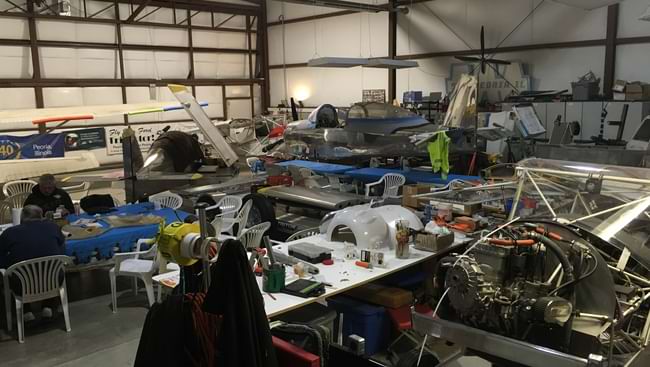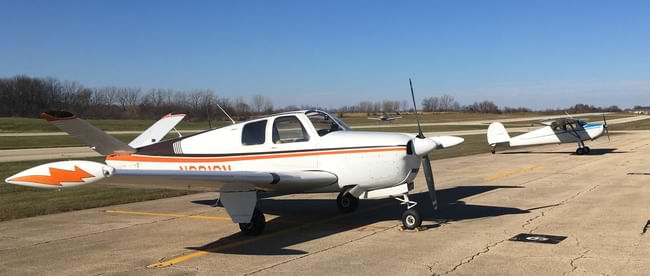With the first Saturday falling on New Year's day, the two breakfasts this month and the meetings which follow will be delayed one week each, to the 8th and the 22nd. The normal schedule will resume in February.
The VMC and IMC Clubs meet at their usual day and time this month. The VMC Club has been growing slowly, and the monthly agenda includes a scenario from Pilot Workshops and a VFR quiz plus a scenario from HQ.
There was a brief board meeting mid December. Despite the mild weather, the most recent heating bill was a record high. Please turn the heat down to level 2 on both thermostats when you are the last person to leave the hangar.
During the last week of January, HQ is presenting dozens of webinars on various aspects of building an aircraft. It's not too late for you to sign up to attend.
At the December meeting, the membership voted to proceed with an airplane build for local teenagers. We have six members willing to mentor the build: Morrie Caudill, Bill Larson, Greg LePine, Karl Kleimenhagen, Rob Meyer, and Ron Wright, with Greg willing to be the team lead. A donor from outside the chapter, who wishes to remain anonymous, will fund the purchase of a Zenith Cruzer airframe kit. The costs to the chapter include lost rent on the hangar space and insurance for the hull while under construction, the latter as required by our lease. Ron has generously offered to allow completed portions of the project to be stored in the end cap space he rents.
Once the airframe is complete, we must decide whether to sell the project at that point or invest chapter funds for an engine and avionics. Once finished, either just the airframe or a complete airplane is expected to sell for at least the money invested, and so the sale of the project should be able to fund the next build. The tail section and plans have been ordered from Zenith as have a pair of practice kits for each kid, a basic metalworking starter kit from Zenith and a more advanced practice kit from Van's. These are expected by the end of January.
We'd like to have between 4 and 8 teenagers in on the build. Four high schools have been invited to an open house on January 8 at 1:00 to discuss this project. One is a private school, and three are public schools which offer shop classes. While the kids will be encouraged to join EAA, they will not be required to do so, however the standard EAA liability waiver will be required. The plan is to have build sessions two Saturdays a month. During the build, anyone with symptoms of the Wuhan plague will be required to stay away, of course
HQ has approved our application for this radio control kit, and it will be sent to the Flight Club at Dunlap High School. The Club already has a mentor who's a member of the AMA, a requirement with this program. The build will be done at the school.
At the December membership meeting, it was agreed to double our scholarships for aviation mechanics. In addition to the usual $1,000 to Lincoln Land, a like amount will be offered to Lewis University.
Killian Madeley has been selected to attend the Air Academy at OSH 2022, July 27 to August 6. The chapter will cover half the cost, and come January Killian will be eligible to apply for the "campership" grant to further reduces his expenses.
Tim Coverstone, who moved to Arizona this summer, has sold his RV-9 due to the hot and high environment in Flagstaff, Arizona. He hopes to build a Zenith with enough engine to deal with these conditions and be able to carry a few bicycles as well.
Having turned age 90, Morrie Caudill finds he can no longer get liability insurace for his Onex, and it is for sale.

Five projects and a Cessna in the hangar
Regarding Rob's Zenith 750 Super Duty:
On the 750 Super Duty I have been working on the wing systems: navigation/strobe lights in the wingtips, landing lights in the leading edge slats, the heated pitot tube, the magnetometer, the fuel tank sending units, associated wiring and fuel plumbing.
Unusually warm weather for mid December allowed the baggage bay assemblies to be finished and their fuselage tabs for the mounting nutplates to be drilled and primed. Work now resumes on the defect riddled wing kit which RANS supplied.
Before Dave returned to Alaska, Greg LePine assisted with repairs to his Kitfox. This airplane had suffered a ground loop which damaged the wing and collapsed the landing gear. New gear from Grove was installed. The wing was repaired and both wings mounted. Also, the radio and fuel lines were reinstalled. Next spring new carburetor gaskets and a clean out will be required along with reattaching all cowling panels, then it will be ready for flight.

It was 1940s Day in early December with a '47 Bonanza and '46 C-140 parked near the FBO.
Tammy Smallwood has retired, and the airport is looking for someone with an interest in aviation to take her place. The 35 hour per week position will, after a few years, pay $20/hr and includes a pension and medical benefits.
Pedestrians have been seen crossing the field. Call airport operations if you see this.
December 8th, Gene Olson, the director of airports for Peoria, gave a one hour presentation on the plans for Mt. Hawley airport. He first wished to quash rumors that Peoria was looking to be rid of 3MY and noted federal law requires the airport to remain in service for 20 years after any federally funded capital improvements; such improvements have been done here in the last 2 years. He feels the rumor dates back to 2005 when an IDOT employee suggested selling the airport land for commercial use and starting over at a new location, a proposal which IDOT soon rejected as impractical. Gene also noted the airport board has always approved work on 3MY.
Current work includes removal of trees near the field both north and south. A 10 ft high fence is planned for the west side of the field to try to reduce the number of deer entering from the Park District woods which are on the northwest side. Also planned is a PAPI for runway 18 and resurfacing of the north ramp, where transients park near the FBO. Funding for all the near term plans, which is done on a 5 year window, has not been secured. The state no longer funds installation of AWOS, so one is unlikely at 3MY.
Gene clarified the snow removal procedures for the 3MY. Plowing will be done after a snowstorm ends and is done by PIA personnel after clearing at PIA is finished. Until cleared, the field will be posted as closed in the NOTAMs. However, if you will need to get a plane out sooner, give them a one day notice and an effort will be made to clear the runway and a path to your hangar, and to the fuel pump if needed.
If you notice maintenance needed for the field, contact either Mark or Tammy's replacement to have them initiate a work order with the people at PIA. With a work order in the system, it will be tracked and completed, whereas a phone call to the office at PIA may be misplaced or forgotten.
Longer range plans for 3MY are rather ambitious, although one must wonder if this is more in the category of ask for the moon and take what comes. A new FBO to better service business airplanes would be built on the west side of the field. Besides access from Chanute road off University, a road would be built around the north side of the field starting from the access road for the commercial buildings north of Kroger. They are in negotiations with the Park District regarding their woods which would have to be crossed; the airport owns two parcels of land next to the bike trail which they hope to trade. With a new FBO in place, the current one would be demolished, although the airplane maintenance hangar here would remain. (Despite the odor, the current FBO has passed tests for mold.)
Insurance for commercial airplanes can prohibit operations to fields with runways either too narrow or too short. The past extension to a length of 4000' was to address this, and the next step would be to widen the runway to 75' from the current 60'. With a wider runway, the taxiway would have to be moved east some, to about the edge of the ramp. A new FBO to the west would also include a parallel taxiway on the west side of the runway.
There is room in the proposed layout for new T-hangars on the west side near the new FBO, but these would only be built if there was demand for them. The expected price would be on the order of $400/month, so demand is not expected.
Regarding air traffic control, that at PIA will be moved to the St. Louis area in the coming years. There was no update on the proposal to convert runway 18 at 3MY to right traffic.
Gene had only two requests of the pilots using 3MY. One is to promptly report any maintenance issues noticed. The second was to use your radio often. Since early 2020, a computer has been counting the times the CTAF frequency goes active. It's assumed that 3 transmissions are typical per flight operation, although Gene feels 3 is higher than most pilots use at this field. Calling downwind, base, and final each landing will give a hit count more in line with the actual number of operations occurring at 3MY, and the count of operations may affect future funding.
Among the questions which followed, several pilots asked if an automated weather system could be provided at 3MY. A few days later, Gene sent a detailed description of the options he looked into. As to an uncertified weather reporting system via UNICOM, the FAA recommends against such systems, which creates legal concerns for the airport authority. He also considered certified systems. ASOS is out of production, but he did talk to the state about an AWOS system for 3MY. The airport classification for 3MY leaves it not eligible for the highest grade of AWOS, and further, with it not even 9 nm from PIA, the state would require a study to document the weather is significantly different at 3MY. IDOT checked its records and reported the last AWOS they installed was $250,000 and costs about $6,000 per year to keep certified. Gene saw little hope of getting IDOT funding for an AWOS at 3MY. He also noted that commercial operations, such as Part 135 charter, are legal at 3MY by using the weather data from PIA.